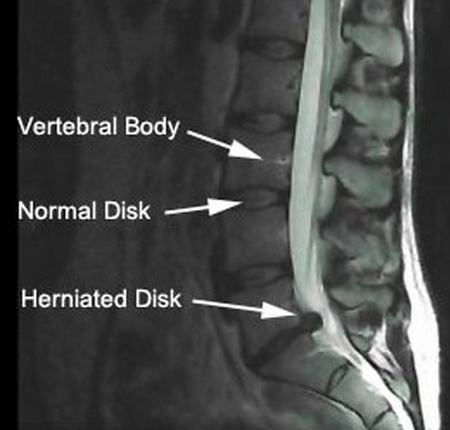
Sciatica & Herniated Discs
A herniated disc refers to a problem with one of the rubbery cushions (discs) between the individual bones (vertebrae) that stack up to make your spine. A spinal disc is a little like a jelly donut, with a softer center encased within a tougher exterior.
Have you been diagnosed with a lumbar disc herniation or disc bulging and are considering surgery? Do you have pain that travels down your leg into your knee, calf, or foot? Is it painful to just try to get out of bed or even tie your shoes in the morning? There are other options out there and our office can help you explore those options without the need of surgical intervention.
First off, disc herniation and disc bulge are incredibly common, and not always painful. There is research suggesting that upward of 60% of middle aged people have asymptomatic disc herniations (http://www.chirogeek.com/000_MRI-Abnormalities_Asymptomatic-Pats.htm). Disc herniation is often painless and is associated with the aging process. Sometimes, though, they can become painful and lead to other issues such as sciatica, which clinically is called “lumbar radiculopathy.”
This happens when the soft center of the disc known as the nuclues, extrudes through the harder, fibrous outer rings that usually contain the nucleus. These rings are called the annulus fibrosis. If the extruding nucleus exits in a way that makes contact with the nearby exiting nerve roots, the resulting nerve irritation can cause pain that travels into the lower extremities. [herniated-disc]
There are several ways to treat this condition. Surgery should be the last option as there are no guarantees that the procedure will be successful, and there are often complications to surgery that last a lifetime. If we feel that surgery is necessary then we will tell you, we strive to provide our patients honest and up front care that doesn't involve you wasting your time at our office without gaining any results. With that in mind, your care is very much that, it's your care and you must take an active stance in it in order to see results. The associated costs are far greater than the non-surgical management, and the post-surgical rehab takes longer than the non-surgical protocols for resolving the issue in the first place.
One of the most important components to treatment is obtaining an accurate diagnosis of the pain generated for the specific patient. As was just mentioned, it is highly possible to have a disc herniation and no symptoms. What this means is that even if you’ve had an MRI that shows a bulging disc, your symptoms may not be being caused by it. There are several reasons people can experience radiating pain, including sciatica pain that have nothing to do with the discs. It’s also true that some symptoms can be caused by more than one issue in the back at once.
Assuming that your pain is disc-derived, non-surgical treatments vary from one practitioner to the other. Generally speaking, there are often movements/exercises that when performed with repetition can ease the symptoms and change the morphology of the disc. When this happens, the patient has found what is called the “directional preference” for exercises that should become the first line of defense against their condition.
Another common treatment for bulging/herniated discs is something called “spinal decompression.” This therapy typically consists of a table the patient lies on while being harnessed at the hips or ankles. The table then uses mechanical traction to lightly decompress the lumbar spine which creates a vacuum effect inside the injured disc. This vacuum effect has been known to reduce the size of the disc bulge over the course of several treatments. This intervention is most often done by chiropractors or doctors of osteopathy (DO) who specialize in the treatment of low back pain.
Next up are stabilization exercises. These exercises increase the stamina of the core more than the strength. This Is done intentionally as research shows core stamina is more important to the protection of the low back than sheer strength. Most of these exercises require no equipment and should be done daily. This treatment should be and is commonly recommended by any practitioner who treats low back pain.
Another component of disc derived low back pain that frankly is often forgotten about during evaluation in most clinics is myofascial pain. Fascia is the name of the connective tissue that covers all the muscles and allows them to slide smoothly over one another. Disc pain often leads to continuous muscle guarding over a period of days or even weeks, and that guarding can derange the fascia which can result in pain. Treating this condition usually requires hands-on manual therapy and is often done by competent massage therapists and some chiropractors.
We would like to point out the differences between spinal decompression tables, which we mentioned above, and flexion/distraction (F/D). At 14th Street Chiropractic, we use F/D tables because of their versatility. A good F/D table not only axially decompresses the spine but gives the leeway to treat the patient according to their directional preference. F/D tables don’t only axially decompress but allow extension, and lateral flexion as well. It’s also directed by the doctor, not a computer.
This allows the patient and doctor to communicate throughout the treatment so the doctor can adjust the treatment according to the tolerance of the patient. Standard axial decompression tables only pull in one direction and are computer guided. They don’t talk to the patient, and they can’t hear a patient explain the way the treatment is affecting them.
